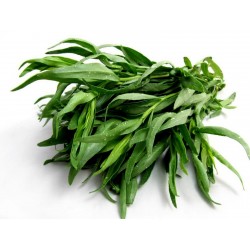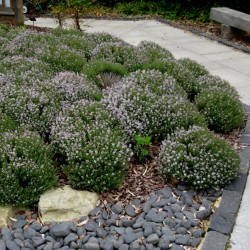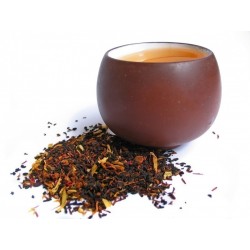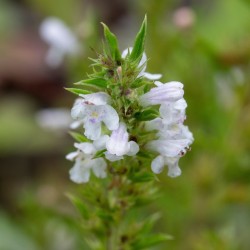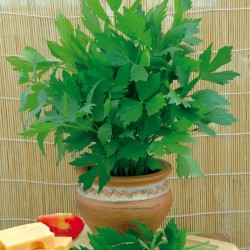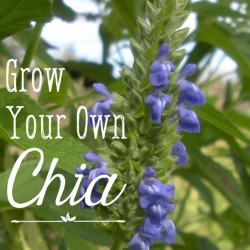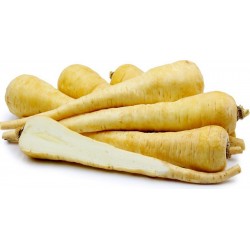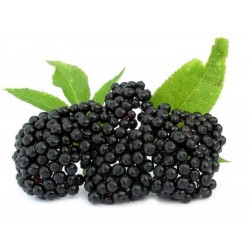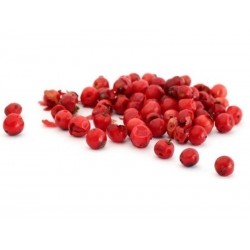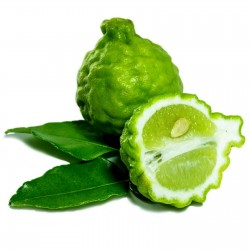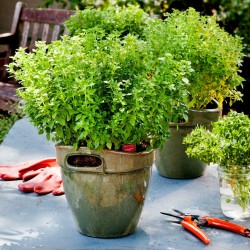
Bush or Greek Basil Seeds...
Cena
1,95 €
SKU: MHS 26
Seeds Gallery Com,
5/
5
<meta http-equiv="Content-Type" content="text/html; charset=UTF-8" />
<h2><strong>Bush or Greek Basil Seeds (Ocimum basilicum)</strong></h2>
<h2><span style="color: #ff0000;"><strong>Price for Package of 100 Seeds.</strong></span></h2>
<p><strong>Bush or Greek basil:<span> </span></strong>Has a strong aroma but mild flavor, so it can be substituted for sweet basil. Forms a compact bush with small leaves and grows well in a pot.</p>
<p><b>Basil</b><span> </span>(<span class="nowrap"><small>UK:<span> </span></small><span class="IPA nopopups noexcerpt">/<span><span title="/ˈ/: primary stress follows">ˈ</span><span title="'b' in 'buy'">b</span><span title="/æ/: 'a' in 'bad'">æ</span><span title="'z' in 'zoom'">z</span><span title="/əl/: 'le' in 'bottle'">əl</span></span>/</span></span>,<sup id="cite_ref-Collins_1-0" class="reference">[1]</sup><span> </span><span class="nowrap"><small>US:<span> </span></small><span class="IPA nopopups noexcerpt">/<span><span title="/ˈ/: primary stress follows">ˈ</span><span title="'b' in 'buy'">b</span><span title="/eɪ/: 'a' in 'face'">eɪ</span><span title="'z' in 'zoom'">z</span><span title="/əl/: 'le' in 'bottle'">əl</span></span>/</span></span>;<sup id="cite_ref-Collins2_2-0" class="reference">[2]</sup><span> </span><i>Ocimum basilicum</i>), also called<span> </span><b>great basil</b><span> </span>or<span> </span><b>Saint-Joseph's-wort</b>, is a<span> </span>culinary herb<span> </span>of the<span> </span>family<span> </span>Lamiaceae<span> </span>(mints).</p>
<p>Basil is native to tropical regions from central Africa to<span> </span>Southeast Asia.<sup id="cite_ref-simon_3-0" class="reference">[3]</sup><span> </span>It is a<span> </span>tender<span> </span>plant, and is used in<span> </span>cuisines<span> </span>worldwide. Depending on the species and cultivar, the leaves may taste somewhat like<span> </span>anise, with a strong, pungent, often sweet smell.</p>
<p>There are many<span> </span>varieties of basil, as well as several related species or hybrids also called basil. The type used commonly as a flavor is typically called<span> </span><b>sweet basil</b><span> </span>(or<span> </span><b>Genovese basil</b>), as opposed to<span> </span>Thai basil<span> </span>(<i>O. basilicum</i><span> </span>var.<span> </span><i>thyrsiflora</i>),<span> </span>lemon basil<span> </span>(<i>O. × citriodorum</i>), and<span> </span>holy basil<span> </span>(<i>Ocimum tenuiflorum</i>). While most common varieties of basil are treated as<span> </span>annuals, some are<span> </span>perennial<span> </span>in warm, tropical climates, including holy basil and a cultivar known as "African blue basil".</p>
<h2><span class="mw-headline" id="Description">Description</span></h2>
<p>Basil is an<span> </span>annual, or sometimes<span> </span>perennial, herb used for its leaves. Depending on the variety, plants can reach between 30 cm (0.98 ft) and 150 cm (4.9 ft). Its leaves are richly green and ovate, but otherwise come in a wide variety of sizes and shapes depending on cultivar. Leaf sizes range from 3 cm (1.2 in) to 11 cm (4.3 in) long, and between 1 cm (0.39 in) and 6 cm (2.4 in) wide. Basil grows a thick, central<span> </span>taproot. Its flowers are small and white, and grow from a central inflorescence that emerges from the central stem atop the plant.<sup class="noprint Inline-Template Template-Fact">[<i><span title="This claim needs references to reliable sources. (April 2019)">citation needed</span></i>]</sup></p>
<h3><span class="mw-headline" id="Phytochemistry">Phytochemistry</span></h3>
<p>The various basils have such different scents because the herb has a number of different<span> </span>essential oils<span> </span>in different proportions for various cultivars.<sup id="cite_ref-simon_3-1" class="reference">[3]</sup><span> </span>The essential oil from European basil contains high concentrations of<span> </span>linalool<span> </span>and<span> </span>methyl chavicol<span> </span>(estragole), in a ratio of about 3:1.<sup id="cite_ref-simon_3-2" class="reference">[3]</sup><sup id="cite_ref-janick_4-0" class="reference">[4]</sup><span> </span>Other constituents include:<span> </span>1,8-cineole,<span> </span>eugenol, and<span> </span>myrcene, among others.<sup id="cite_ref-simon_3-3" class="reference">[3]</sup><sup id="cite_ref-Breitmaier2006_5-0" class="reference">[5]</sup><span> </span>The<span> </span>clove<span> </span>scent of sweet basil is derived from<span> </span>eugenol.<sup id="cite_ref-Islam2011_6-0" class="reference">[6]</sup><span> </span>The aroma profile of basil includes<span> </span>1,8-cineole<sup id="cite_ref-suie_7-0" class="reference">[7]</sup><sup id="cite_ref-edsh_8-0" class="reference">[8]</sup><span> </span>and<span> </span>methyl eugenol.<sup id="cite_ref-suie_7-1" class="reference">[7]</sup><sup id="cite_ref-mobg_9-0" class="reference">[9]</sup></p>
<h2><span class="mw-headline" id="Taxonomy">Taxonomy</span></h2>
<div class="hatnote navigation-not-searchable">Further information:<span> </span>List of basil cultivars</div>
<p>The exact taxonomy of basil is uncertain due to the immense number of cultivars, its ready polymorphy, and frequent cross-pollination (resulting in new hybrids) with other members of the genus<span> </span><i>Ocimum</i><span> </span>and within the species.<span> </span><i>Ocimum basilicum</i><span> </span>has at least 60 varieties, which further complicates taxonomy.<sup id="cite_ref-simon_3-4" class="reference">[3]</sup></p>
<p>Most basils are cultivars of sweet basil.</p>
<ul>
<li>Anise basil,<span> </span>Licorice basil<span> </span>or<span> </span>Persian basil<span> </span>(<i>O. basilicum</i><span> </span>'Licorice')</li>
<li>Cinnamon basil<span> </span>(<i>Ocimum basilicum</i><span> </span>'Cinnamon')</li>
<li>Dark opal basil<span> </span>(<i>Ocimum basilicum</i><span> </span>'Dark Opal')</li>
<li>Lettuce leaf basil<span> </span>(<i>Ocimum basilicum</i><span> </span>'Crispum')</li>
<li>Purple basil (<i>Ocimum basilicum</i><span> </span>'Purpurescens')</li>
<li>Rubin basil<span> </span>(<i>Ocimum basilicum</i><span> </span>'Rubin')</li>
<li>Globe basil, dwarf basil, French basil (<i>Ocimum basilicum</i><span> </span>'Minimum'<sup id="cite_ref-10" class="reference">[10]</sup>)</li>
<li>Thai basil<span> </span>(<i>Ocimum basilicum thyrsifolium</i>)</li>
</ul>
<h3><span class="mw-headline" id="Hybrids">Hybrids</span></h3>
<ul>
<li>African blue basil<span> </span>(<i>Ocimum basilicum X O. kilimandscharicum</i>)</li>
<li>Spice basil (<i>Ocimum basilicum X O. americanum</i>), which is sometimes sold as holy basil)</li>
<li>Lemon basil<span> </span>(<i>Ocimum basilicum X O. americanum</i><sup id="cite_ref-11" class="reference">[11]</sup><sup id="cite_ref-12" class="reference">[12]</sup>)</li>
</ul>
<h3><span class="mw-headline" id="Similar_species">Similar species</span></h3>
<ul>
<li>Camphor basil, African basil (<i>O. kilimandscharicum</i>)</li>
<li>Clove basil, also African basil (<i>Ocimum gratissimum</i><sup id="cite_ref-tgte_13-0" class="reference">[13]</sup><sup id="cite_ref-aaeo_14-0" class="reference">[14]</sup>)</li>
<li>Holy basil<span> </span>(<i>Ocimum tenuiflorum</i>, formerly known as<span> </span><i>O. sanctum</i>)</li>
</ul>
<h3><span class="mw-headline" id="Other_cultivars">Other cultivars</span></h3>
<p>Several other basils, including some other<span> </span><i>Ocimum</i><span> </span>species, are grown in many regions of Asia. Most of the Asian basils have a<span> </span>clove-like flavor that is, in general, stronger than the Mediterranean basils. The most notable is the holy basil or<span> </span>tulsi, a revered home-grown plant in India and<span> </span>Nepal.</p>
<p>Lemon basil has a strong<span> </span>lemony<span> </span>smell and flavor very different from those of other varieties because it contains a chemical called<span> </span>citral. It is widely used in<span> </span>Indonesia, where it is called<span> </span><i>kemangi</i>, served raw together with raw<span> </span>cabbage,<span> </span>green beans, and<span> </span>cucumber<span> </span>as an accompaniment to fried fish or duck. Its flowers, when broken up, are a zesty<span> </span>saladcondiment.</p>
<h3><span class="mw-headline" id="Etymology">Etymology</span></h3>
<p>The name "basil" comes from Latin,<span> </span><i>basilius</i>, and Greek βασιλικόν φυτόν (<i>basilikón phutón</i>), "royal/kingly plant", possibly because the plant was believed to have been used in production of royal perfumes.<sup id="cite_ref-eo_15-0" class="reference">[15]</sup><span> </span>The Latin name has been confused with<span> </span>basilisk, as it was supposed to be an<span> </span>antidote<span> </span>to the basilisk's venom.<sup id="cite_ref-eo_15-1" class="reference">[15]</sup></p>
<h2><span class="mw-headline" id="Distribution_and_habitat">Distribution and habitat</span></h2>
<p>Basil is native to India and other tropical regions stretching from Africa to Southeast Asia, but has now become globalized due to human cultivation.<sup id="cite_ref-simon_3-5" class="reference">[3]</sup></p>
<h2><span class="mw-headline" id="Cultivation">Cultivation</span></h2>
<p>Most culinary and ornamental basils are cultivars of the species<span> </span><i>Ocimum basilicum</i>, but other species are also grown and there are many hybrids between species. Traditionally a green plant, some varieties, such as 'Purple Delight' have leaves that appear purple. Basil grows between 30–130 cm (12–51 in) tall, with opposite, light green, silky<span> </span>leaves<span> </span>3–11 cm (1.2–4.3 in) long and 1–6 cm (0.39–2.36 in) broad. The flowers are small, white in color and arranged in a terminal<span> </span>spike. Unusual among Lamiaceae, the four<span> </span>stamens<span> </span>and the<span> </span>pistil<span> </span>are not pushed under the upper lip of the<span> </span>corolla, but lie over the inferior lip. After<span> </span>entomophilous<span> </span>pollination, the corolla falls off and four round<span> </span>achenes<span> </span>develop inside the bilabiate<span> </span>calyx.</p>
<p>Basil is sensitive to cold, with best growth in hot, dry conditions. It behaves as an annual if there is any chance of a frost. However, due to its popularity, basil is cultivated in many countries around the world. Production areas include countries in the Mediterranean area, those in the<span> </span>temperate zone, and others in<span> </span>subtropical<span> </span>climates.<sup id="cite_ref-16" class="reference">[16]</sup></p>
<p>In Northern Europe, Canada, the northern states of the U.S., and the South Island of New Zealand it will grow best if sown under glass in a<span> </span>peat<span> </span>pot, then planted out in late spring/early summer (when there is little chance of a frost). Additionally, it may be sown in soil once chance of frost is past. It fares best in well-drained, sunny exposure.</p>
<p>Although basil grows best outdoors, it can be grown indoors in a pot and, like most herbs, will do best on a sun-facing windowsill. It should be kept away from extremely cold drafts, and grows best in strong sunlight, therefore a<span> </span>greenhouse<span> </span>or<span> </span>row cover<span> </span>is ideal if available. It can, however, be grown even in a basement, under fluorescent lights.</p>
<p>If its leaves have wilted from lack of water, it will recover if watered thoroughly and placed in a sunny location. Yellow leaves towards the bottom of the plant are an indication that the plant has been stressed; usually this means that it needs less water, or less or more fertilizer.</p>
<p>In sunnier climates such as Southern Europe, the southern states of the U.S., the North Island of New Zealand, and Australia, basil will thrive when planted outside. It also thrives over the summertime in the central and northern United States, but dies out when temperatures reach freezing point. It will grow back the next year if allowed to go to seed. It will need regular watering, but not as much attention as is needed in other climates.</p>
<p>Basil can also be propagated reliably from cuttings with the stems of short cuttings suspended for two weeks or so in water until roots develop.</p>
<p>Once a stem produces flowers, foliage production stops on that stem, the stem becomes woody, and essential oil production declines. To prevent this, a basil-grower may pinch off any flower stems before they are fully mature. Because only the blooming stem is so affected, some stems can be pinched for leaf production, while others are left to bloom for decoration or seeds.</p>
<p>Once the plant is allowed to flower, it may produce seed pods containing small black seeds, which can be saved and planted the following year. Picking the leaves off the plant helps promote growth, largely because the plant responds by converting pairs of leaflets next to the topmost leaves into new stems.</p>
<p>Basil is popularly recommended as a<span> </span>companion plant<span> </span>to the<span> </span>tomato. Common claims are that basil may deter pests or improve tomato flavor. However, in double-blind taste tests, basil did not significantly affect the taste of tomatoes when planted adjacent to them.<sup id="cite_ref-18" class="reference"></sup></p>
<h3><span class="mw-headline" id="Diseases">Diseases</span></h3>
<p>Basil suffers from several plant pathogens that can ruin the crop and reduce<span> </span>yield.<span> </span>Fusarium wilt<span> </span>is a soil-borne fungal disease that will quickly kill younger basil plants.<span> </span>Seedlings<span> </span>may be killed by<span> </span><i>Pythium</i><span> </span>damping off. A common<span> </span>foliar<span> </span>disease of basil is<span> </span>gray mold<span> </span>caused by<span> </span><i>Botrytis cinerea</i>; it can cause infections post-harvest and is capable of killing the entire plant.<span> </span>Black spot<span> </span>can be seen on basil foliage and is caused by the<span> </span>fungigenus<span> </span><i>Colletotrichum</i>.<span> </span>Downy mildew<span> </span>caused by<span> </span><i>Peronospora belbahrii</i><span> </span>is a significant disease, as first reported in Italy in 2004.<sup id="cite_ref-19" class="reference">[19]</sup><span> </span>It was reported in the U.S. in 2007 and 2008.<sup id="cite_ref-21" class="reference"></sup></p>
<p>Non-pathogenic bacteria found on basil include<span> </span><i>Novosphingobium</i><span> </span>species.</p>
<h2><span class="mw-headline" id="Uses">Uses</span></h2>
<div class="thumb tleft">
<div class="thumbinner"><img alt="" src="https://upload.wikimedia.org/wikipedia/commons/thumb/7/72/Basilic-spice.jpg/200px-Basilic-spice.jpg" width="200" height="126" class="thumbimage" />
<div class="thumbcaption">
<div class="magnify"></div>
Dried basil leaves</div>
</div>
</div>
<h3><span class="mw-headline" id="Culinary">Culinary</span></h3>
<p>Basil is most commonly used fresh in recipes. In general, it is added at the last moment, as cooking quickly destroys the flavor. The fresh herb can be kept for a short time in plastic bags in the refrigerator, or for a longer period in the freezer, after being<span> </span>blanched<span> </span>quickly in boiling water. The dried herb also loses most of its flavor, and what little flavor remains tastes very different, with a weak<span> </span>coumarin<span> </span>flavor, like<span> </span>hay.<sup class="noprint Inline-Template Template-Fact">[<i><span title="This claim needs references to reliable sources. (July 2018)">citation needed</span></i>]</sup></p>
<p>Basil is one of the main ingredients in<span> </span>pesto—a green Italian oil-and-herb sauce.</p>
<p>The most commonly used Mediterranean basil<span> </span>cultivars<span> </span>are "Genovese", "Purple Ruffles", "Mammoth", "Cinnamon", "Lemon", "Globe", and "African Blue". The<span> </span>Chinese<span> </span>also use fresh or dried basils in soups and other foods. In<span> </span>Taiwan, people add fresh basil leaves to thick soups. They also eat<span> </span>fried chicken<span> </span>with deep-fried basil leaves. Basil (most commonly Thai basil) is commonly steeped in cream or milk to create an interesting flavor in ice cream or chocolates (such as truffles). The leaves are not the only part of basil used in culinary applications, the flower buds have a more subtle flavor and they are edible.</p>
<h4><span class="mw-headline" id="Seeds">Seeds</span></h4>
<p>When soaked in water, the seeds of several basil varieties become gelatinous, and are used in Asian drinks and desserts such as<span> </span><i>faluda</i>,<span> </span><i>sharbat-e-rihan</i>, or<span> </span><i>hột é</i>.</p>
<p>Research studies of the essential oil showed antifungal and insect-repelling properties,<sup id="cite_ref-apia_23-0" class="reference">[23]</sup><span> </span>including potential toxicity to<span> </span>mosquitos.<sup id="cite_ref-etdp_24-0" class="reference">[24]</sup></p>
<h3><span class="mw-headline" id="Folk_medicine">Folk medicine</span></h3>
<p>In<span> </span>folk medicine<span> </span>practices, such as those of<span> </span>Ayurveda<span> </span>or<span> </span>traditional Chinese medicine, basil is thought to have therapeutic properties.<sup id="cite_ref-25" class="reference">[25]</sup><sup id="cite_ref-:1_26-0" class="reference">[26]</sup></p>
<h2><span class="mw-headline" id="Culture">Culture</span></h2>
<p>There are many rituals and beliefs associated with basil. The French sometimes call basil "<i>l'herbe royale</i>" ("royal herb"),<sup id="cite_ref-CarrollVona2006_27-0" class="reference">[27]</sup><span> </span>while Jewish folklore suggests it adds strength while fasting.<sup id="cite_ref-Navarra2004_28-0" class="reference">[28]</sup><span> </span>In<span> </span>Portugal, dwarf bush basil is traditionally presented in a pot, together with a poem and a paper<span> </span>carnation, to a sweetheart, on the religious holidays of Saint John and Saint Anthony. However, basil represented hatred in ancient<span> </span>Greece, and European lore sometimes claims that basil is a symbol of<span> </span>Satan.<sup id="cite_ref-Arrowsmith2009_29-0" class="reference">[29]</sup></p>
<p>Holy basil, also called<span> </span>tulsi, is highly revered in<span> </span>Hinduism.</p>
<p>Basil has religious significance in the<span> </span>Greek Orthodox Church, where it is used to sprinkle holy water.<sup id="cite_ref-blessing-of-the-waters_30-0" class="reference">[30]</sup><span> </span>The<span> </span>Bulgarian Orthodox Church,<span> </span>Serbian Orthodox Church,<span> </span>Macedonian Orthodox Church<span> </span>and<span> </span>Romanian Orthodox Church<span> </span>use basil (Bulgarian and Macedonian:<span> </span><i>босилек</i>;<span> </span>Romanian:<span> </span><i>busuioc</i>,<span> </span>Serbian:<span> </span><span lang="sr" xml:lang="sr">босиљак</span>) to prepare holy water and pots of basil are often placed below church altars.<sup id="cite_ref-MacDermott1998_31-0" class="reference">[31]</sup></p>
<p>In Europe, basil is placed in the hands of the dead to ensure a safe journey.<sup id="cite_ref-CEPC2007_32-0" class="reference">[32]</sup><span> </span>In India, they place it in the mouth of the dying to ensure they reach God.<sup id="cite_ref-Bregman2010_33-0" class="reference">[33]</sup><span> </span>The ancient Egyptians and ancient Greeks believed it would open the gates of heaven for a person passing on.<sup id="cite_ref-Nelson-Shellenbarger2013_34-0" class="reference">[34]</sup></p>
<table cellspacing="0" cellpadding="0" border="1">
<tbody>
<tr>
<td colspan="2" width="100%" valign="top">
<p><span style="color: #008000;"><strong>Sowing Instructions</strong></span></p>
</td>
</tr>
<tr>
<td valign="top" nowrap="nowrap">
<p><span style="color: #008000;"><strong>Propagation:</strong></span></p>
</td>
<td valign="top">
<p><span style="color: #008000;">Seeds</span></p>
</td>
</tr>
<tr>
<td valign="top" nowrap="nowrap">
<p><span style="color: #008000;"><strong>Pretreat:</strong></span></p>
</td>
<td valign="top">
<p><span style="color: #008000;">0</span></p>
</td>
</tr>
<tr>
<td valign="top" nowrap="nowrap">
<p><span style="color: #008000;"><strong>Stratification:</strong></span></p>
</td>
<td valign="top">
<p><span style="color: #008000;">0</span></p>
</td>
</tr>
<tr>
<td valign="top" nowrap="nowrap">
<p><span style="color: #008000;"><strong>Sowing Time:</strong></span></p>
</td>
<td valign="top">
<p><span style="color: #008000;">all year round</span></p>
</td>
</tr>
<tr>
<td valign="top" nowrap="nowrap">
<p><span style="color: #008000;"><strong>Sowing Depth:</strong></span></p>
</td>
<td valign="top">
<p><span style="color: #008000;">Needs Light to germinate! Just sprinkle on the surface of the substrate + gently press</span></p>
</td>
</tr>
<tr>
<td valign="top" nowrap="nowrap">
<p><span style="color: #008000;"><strong>Sowing Mix:</strong></span></p>
</td>
<td valign="top">
<p><span style="color: #008000;">Coir or sowing mix + sand or perlite</span></p>
</td>
</tr>
<tr>
<td valign="top" nowrap="nowrap">
<p><span style="color: #008000;"><strong>Germination temperature:</strong></span></p>
</td>
<td valign="top">
<p><span style="color: #008000;">18-20 ° C</span></p>
</td>
</tr>
<tr>
<td valign="top" nowrap="nowrap">
<p><span style="color: #008000;"><strong>Location:</strong></span></p>
</td>
<td valign="top">
<p><span style="color: #008000;">bright + keep constantly moist not wet</span></p>
</td>
</tr>
<tr>
<td valign="top" nowrap="nowrap">
<p><span style="color: #008000;"><strong>Germination Time:</strong></span></p>
</td>
<td valign="top">
<p><span style="color: #008000;">1-2 weeks</span></p>
</td>
</tr>
<tr>
<td valign="top" nowrap="nowrap">
<p><span style="color: #008000;"><strong>Watering:</strong></span></p>
</td>
<td valign="top">
<p><span style="color: #008000;">Water regularly during the growing season</span></p>
</td>
</tr>
<tr>
<td valign="top" nowrap="nowrap">
<p><span style="color: #008000;"><strong> </strong></span></p>
</td>
<td valign="top">
<p><br /><span style="color: #008000;"><em>Copyright © 2012 Seeds Gallery - Saatgut Galerie - Galerija semena. </em><em>All Rights Reserved.</em></span></p>
</td>
</tr>
</tbody>
</table>
MHS 26 (100 S)





